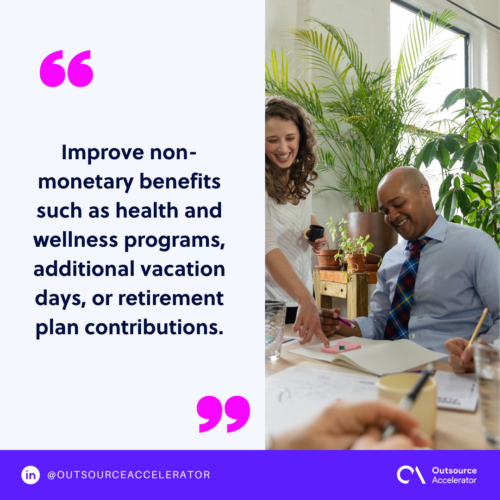The paradox of dry promotion: Rising titles with frozen salaries

Promoting employees is a fundamental aspect of business growth and employee satisfaction. It involves advancing an employee to a higher position, often accompanied by increased responsibilities, recognition, and compensation.
Promotions are not only a reward for hard work and dedication but also a strategic move by employers to retain top talent and drive organizational success.
However, a step up the ladder does not usually come with the perks employees expect.
A 2024 survey by benefits-advisory firm Mercer, involving 900 companies, revealed that fewer organizations are allocating salary budgets for promotion-related raises compared to previous years.
After The Great Resignation and The Great Return, “dry promotion” is becoming a buzzword in the modern workplace.
In this article, we will delve into what dry promotion entails, explore its causes, and highlight some alternatives employers can offer to keep their workforce motivated and engaged.
What is dry promotion?
A “dry promotion” occurs when an employee is given a higher job title and additional responsibilities without a corresponding increase in salary or benefits.

While the new title might seem like a step up, the lack of financial or tangible rewards can lead to feelings of disappointment and undervaluation.
Dry promotions are becoming more common in today’s work environment due to various factors. However, this practice can have significant implications for employee morale and retention.
Employees might feel that their efforts and achievements are not being adequately recognized, leading to decreased motivation and potential turnover.
In fact, ADP Research’s data in “The Hidden Truth About Promotions” reveals that 29% of employees leave within a month of receiving a promotion without a pay raise.
Understanding the impact of dry promotion is crucial for employers aiming to maintain a motivated and loyal workforce.
Organizations must address its root cause and explore viable alternatives to create a more supportive and rewarding environment for their employees.
Why does dry promotion occur?
Dry promotions, though often well-intentioned, can stem from various underlying issues within an organization.
Understanding these causes can help employers address and mitigate the negative impacts on their workforce:
Budget constraints
Companies may face financial limitations that prevent them from offering salary increases alongside promotions. This is particularly common in startups or during economic downturns.
Organizational restructuring
During periods of restructuring, companies might reassign roles and responsibilities without adjusting compensation. Dry promotions are often implemented as a temporary measure.
Market conditions
In competitive industries, companies might prioritize retaining top talent through promotions to prevent them from seeking opportunities elsewhere. However, financial rewards are delayed.
Internal pay structures
Existing pay scales and internal salary structures might restrict immediate pay increases. As a result, title promotions are without corresponding raises until the next review cycle.
By identifying these causes, employers can better navigate the challenges associated with this dilemma and explore alternative strategies to keep their employees motivated and valued.
7 alternatives to dry promotion
When budget constraints or other factors prevent financial rewards for promotions, employers can explore alternative strategies to recognize and motivate their employees.
These options can help maintain morale and demonstrate appreciation for hard work and dedication:
1. Professional development opportunities
Offer training programs, workshops, or courses that help employees enhance their skills and advance their careers. Providing opportunities for continuous learning can be a valuable incentive.
2. Flexible work arrangements
Allow employees to have flexible working hours or remote work options. This can improve work-life balance and show that the company values their well-being and personal needs.
3. Increased responsibility with autonomy
Grant employees more autonomy and decision-making power in their new roles. Empowering them to take ownership of projects can boost their sense of accomplishment and job satisfaction.
4. Recognition and awards
Implement a formal recognition program that acknowledges employees’ achievements. Organizations may compensate employees by giving awards, public recognition, or special perks (e.g., extra time off or gift cards).
5. Career path planning
Work with employees to create a clear career development plan, outlining potential future opportunities and the steps needed to achieve them.
Effective career path planning demonstrates long-term investment in their growth.
6. Mentorship programs
Establish mentorship opportunities where employees can receive guidance and support from more experienced colleagues. This fosters personal and professional growth, enhancing job satisfaction.
7. Enhanced benefits
Improve non-monetary benefits such as health and wellness programs, additional vacation days, or retirement plan contributions. Enhanced benefits can compensate for the lack of immediate financial rewards.
These alternatives help employers create a supportive and engaging work environment that recognizes employees’ contributions and promotes their overall development and well-being.

Dry promotion: A new trend in the workplace?
While dry promotions have gained attention in recent years, they are not entirely new.
What is new, however, is the increased scrutiny and dialogue around this practice as organizations strive to balance financial limitations with employee satisfaction.
As the workplace evolves, understanding and addressing the causes and impacts of dry promotions becomes essential.
By exploring and implementing viable alternatives, employers can ensure they recognize and reward their employees effectively, fostering a motivated and loyal workforce.
In doing so, companies can navigate the complexities of modern employment dynamics and build a more resilient and engaged team.







 Independent
Independent




